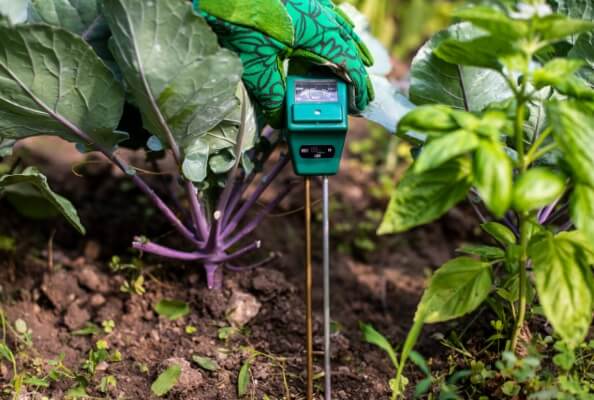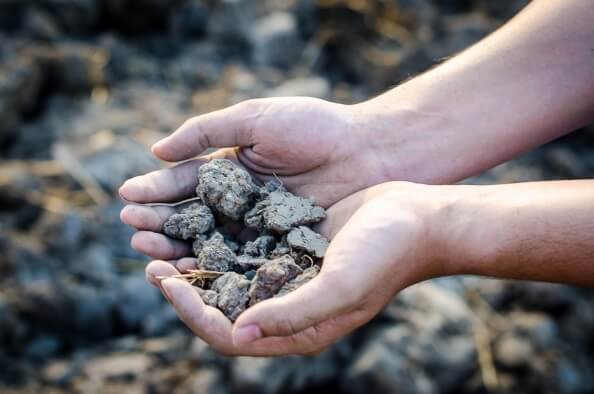As a professional horticulturalist, an avid gardener or a complete novice, the soil we use is the foundation of our success each season.
The type of soil we have dictates what will grow well and what will fail. Yet, for many reasons, so many of us (myself included!) fail to test our soil to find out what kind it is, before we start planting.
The two main things we should be testing are:
pH level – whether the soil is acidic, neutral or alkaline
Soil texture – whether our soil is sandy, silty or clay (this affects how much moisture it will hold and how quickly it warms up to be ready for planting)
That said, it’s also worth thinking about the safety of soil, particularly in areas where edible produce will be grown.
There are simple off-the-shelf soil testing kits available for this, and you can read more on this in our soil testing article.

I studied soil types during my RHS horticultural training so my awareness is good but I needed to put my learning into action. For less than £10, I purchased a 3-in-1 soil meter from a well-known online delivery shop. It tests pH, moisture and light levels.
The thing that interested me most was the pH level of the soil. I have always known that our soil is not acidic having miserably failed over the years to grow plants that I adore, such as Heathers, Rhododendrons and Azaleas. These are all now squashed into pots with ericaceous soil (so I will be using the moisture part of the soil meter once the weather warms up). I eagerly opened the soil meter and went outside to test it.
Unsurprisingly, I found that all around our garden the soil is pH 7, which is neutral. I thought there may be variation in different parts of the garden however, it was consistent all around the garden.
Interestingly, my calcifuges (acid-loving plants) such as my potted Rhododendrons and Camellias came up with pH of 6-7.5. This showed me, in black and white, the reason why they are no longer looking vibrant and healthy but have turned a yellow-looking colour. These plants are sitting in a soil that is not the correct pH for them. They need a pH of 5-6. So, in a few weeks time I will be replacing the soil in their pots to ensure it is ericaceous. Then it will allow the plants to access the nutrients that they need from the soil so that they can grow strong and healthy and put on a good show this year.
Soil texture in our garden has always been obvious, we have heavy clay. In fact, when the children were little our soil was so ‘clayey’ that they made little pots out of it. Over the years, we have battled to improve our soil by adding as much home-made compost as we can, using a raised bed system and mulching with a variety of mulches. We are getting there but it is taking its time.
In order to find out what soil texture you have, you can do the simple touch test:
Take a small amount of soil and roll it in your hands.

Once you’ve identified your soil texture, you can get an understanding of it’s characteristics including its moisture retention abilities and nutrient content and you can work out suitable planting times. All of these things affect how well your plants will or will not grow.
If you have a soil with little nutrient retention then you will need to add extra nutrients to it to help your plants grow strong and be pest and disease resistant. Use an organic fertiliser or add additional organic matter for long-term benefits and plant health.
You can achieve the best results by mulching with garden compost or bark chippings. Alternatively, you can add a soil improver such as a home-made comfrey or nettle tea.
If you choose to purchase a fertiliser, look for an organic product. While inorganic methods may appear to give an initial boost, the longer-term impact is negative, weakening soil and harming the soil’s microbiology.
Water retention is highly important – in times of too much or too little rain.
When there is too much rain, clay soil becomes in danger of water logging which will stunt plant growth. Incorporating organic matter into the soil such as home-made garden compost or bought compost will add air pockets to the soil and improve drainage.
In times of drought, clay soil will dry out and risks ‘capping’ (where a hard surface forms that water cannot then penetrate). Again, adding organic matter or mulching will help prevent this. I will be using the water meter in the summer to help me measure the moisture content in the soil so I don’t waste unnecessary time and water, watering when it is not needed.
To improve the water retention in sandy soil, adding a mulch or incorporating organic matter helps by reducing the gaps between particles and giving the soil the capability to hold more moisture.
Sandy soils warm up quickly meaning you can sow seeds directly into your sandy soil once the soil temperatures reach 7 degrees or higher. Clay soils take longer to warm up so ensure you delay your direct sowing until the soil temperature is right. If you are lucky enough to have that highly sought after silty soil then you won’t have to wait as it isn’t too far behind sandy soil when it comes to warming up and being ready for seed sowing.
Testing the soil has been a worthwhile activity. I am now aware of the pH of my soil for sure and can now “plant the right plant in the right place” (Beth Chatto). Also, by doing the touch test in the different beds in my garden, I can see which ones require lots of mulch or soil improver come the autumn time. I would heartily recommend getting a soil meter to help you identify your garden soil or do the touch test to see what soil type you have. Then all the plants in your garden will be on the road to long-lasting success.
Guest Author: Nicky Sharp
Nicky is a green-fingered mum of three who until recently was a self-taught gardener. Having left her teaching career to support her young family, she has now been able to pursue her passion for horticulture, recently embarking on an RHS course to enhance her expertise.